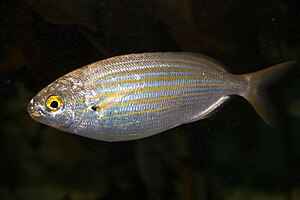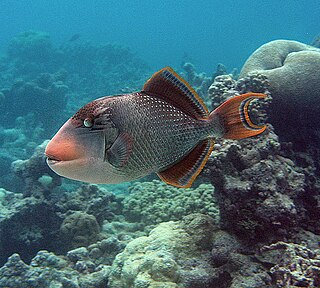
The yellowmargin triggerfish, pineapple trigger, yellowface triggerfish or yellow-face triggerfish is a marine fish in the family Balistidae. It is found in coastal tropical waters and reefs of the Indo-Pacific from the Red Sea south to Natal, South Africa and east from southern Japan south to Indonesia, the Philippines and Samoa, at water depths from 2–50 m (6.6–164.0 ft).

Rabbitfishes or spinefoots, genus Siganus, are perciform fishes in the family Siganidae. It is the only extant genus in its family and has 29 species. In some now obsolete classifications, the species having prominent face stripes—colloquially called foxfaces–are in the genus Lo. Other species, such as the masked spinefoot, show a reduced form of the stripe pattern. Rabbitfishes are native to shallow waters in the Indo-Pacific, but S. luridus and S. rivulatus have become established in the eastern Mediterranean via Lessepsian migration. They are commercially important food fish, and can be used in the preparation of dishes such as bagoong.

Siganidae, the rabbitfishes, are a small family of ray-finned fishes in the order Perciformes. The only extant genus is Siganus, the rabbitfish and spinefoot. However, a number of genera are known from fossils.
Ichthyoallyeinotoxism, or hallucinogenic fish inebriation, comes from eating certain species of fish found in several parts of the tropics, the effects of which are reputed to be similar in some aspects to LSD. Experiences may include vivid auditory and visual hallucinations. This has given rise to the collective common name "dream fish" for ichthyoallyeinotoxic fish.

The yellow goatfish, also known as yellowsaddle, is a species of goatfish native to the Atlantic Ocean around the coasts of Africa and the Americas. This species can reach a total length of 39.4 cm (15.5 in), but most reach lengths only around 28 cm (11 in). They are of minor importance to local commercial fisheries, though they have been reported to carry the ciguatera toxin.
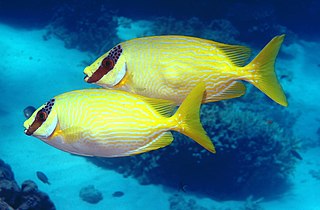
The masked spinefoot, also known as the masked rabbitfish, bluelined rabbitfish, blue-lined spinefoot, decorated rabbitfish or maiden spinefoot, is a species of marine ray-finned fish, a rabbitfish belonging to the family Siganidae. It occurs in shallow, coral-rich areas of clear lagoons and seaward reefs of the Indo-West Pacific region.

The salema porgy, also known as the dreamfish, salema, cow bream, karanteen, salpa, saupe, strepie or goldline, is a species of marine ray-finned fish belonging to the family Sparidae, which includes the seabreams and porgies. It is the only species in the monospecific genus Sarpa. It is found in the eastern Atlantic Ocean, Mediterranean Sea and southwestern Indian Ocean. This species has been known to cause ichthyoallyeinotoxism when eaten.

Fish are very diverse animals and can be categorised in many ways. Although most fish species have probably been discovered and described, about 250 new ones are still discovered every year. According to FishBase about 34,800 species of fish had been described as of February 2022, which is more than the combined total of all other vertebrate species: mammals, amphibians, reptiles and birds.
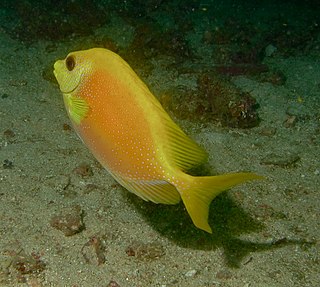
The blue-spotted spinefoot, the coral rabbitfish, coral spinefoot, ocellated spinefoot or orange spinefoot is a species of marine ray-finned fish, a rabbitfish belonging to the family Siganidae. It is found in the Indo-Pacific where it is often caught as a food fish and occasionally as an aquarium fish.

Siganus doliatus, commonly known as the barred spinefoot, scribbled rabbitfish, pencil-streaked rabbitfish, barred Spanish mackerel, blue-lined rabbitfish or two-barred rabbitfish, is a species of marine ray-finned fish, a rabbitfish belonging to the family Siganidae. It is native to the western Pacific Ocean where it occurs on reefs and in lagoons.
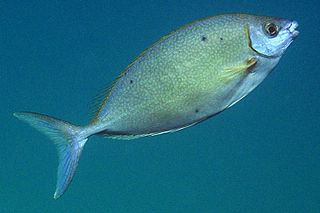
The streamlined spinefoot, also known as the forktail rabbitfish, schooling rabbitfish or silver spinefoot, is a species of marine ray-finned fish, a rabbitfish belonging to the family Siganidae. It is found in the Indo-Pacific region.
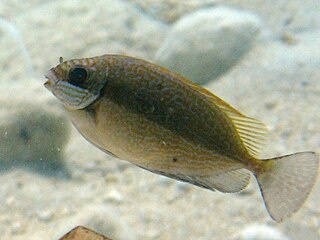
The dusky spinefoot, also known as the squaretail rabbitfish, is a species of marine ray-finned fish, a rabbitfish belonging to the family Siganidae. It is native to the western Indian Ocean which has spread to the Mediterranean Sea through the Suez Canal. Its fin spines contain venom. It is regarded as a food fish.

Siganus insomnis, the bronze-lined spinefoot, is a species of marine ray-finned fish, a rabbitfish belonging to the family Siganidae. It is found in the northern central Indian Ocean. It had formerly been confused with S. lineatus, but was recognized as a separate species in 2014.

Poisonous fish are fish that are poisonous to eat. They contain toxins which are not destroyed by the digestive systems of animals that eat the fish. Venomous fish also contain toxins, but do not necessarily cause poisoning if they are eaten, since the digestive system often destroys their venom.

Siganus rivulatus, the marbled spinefoot, rivulated rabbitfish or surf parrotfish, is a gregarious, largely herbivorous ray-finned fish of the family Siganidae. Its natural range encompasses the western Indian Ocean and the Red Sea from where it colonised the Mediterranean Sea by Lessepsian migration through the Suez Canal. It is the type species of the genus Siganus.
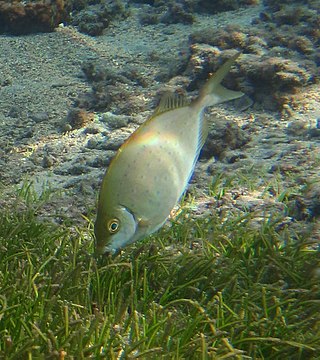
Siganus sutor, the shoemaker spinefoot rabbitfish ,whitespotted rabbitfish or African whitespotted rabbitfish, is a species of marine ray-finned fish, a rabbitfish belonging to the family Siganidae. It lives in Indo-Pacific coral reefs. It is endemic to the Indian Ocean, from Indonesia to Comoros. S. sutor is one of the commercial marine fishes, which is ubiquitously caught, in Tanzania and the entire East African coast of the Indian Ocean. S. sutor is among the most common fish species in the marine fisheries of Kenya, and accounts for around 40% of the artisanal fishery landings. Various fishing gears are used to target the siganids, but basket traps are the preferred ones. It is one of the mangrove/seagrass-associated coral reef fishes. This species inhabits littoral areas and its fin spines are venomous to humans.

Siganus fuscescens, the mottled spinefoot, black rabbitfish, black spinefoot, dusky rabbitfish, fuscous rabbitfish, happy moments, mi mi, pearl-spotted spinefoot, pin-spotted spinefoot, stinging bream or West Australian rabbitfish, is a species of marine ray-finned fish, a rabbitfish belonging to the family Siganidae. It is found in the Western Pacific Ocean.

Siganus randalli, the variegated spinefoot or Randall's rabbitfish, is a species of marine ray-finned fish, a rabbitfish belonging to the family Siganidae. It is found in the Western Pacific Ocean.

Siganus stellatus, the brown-spotted spinefoot, brown-spotted rabbitfish, honeycomb rabbitfish, starspotted spinefoot, starspotted rabbitfish or stellate rabbitfish is a species of marine ray-finned fish, a rabbitfish belonging to the family Siganidae. It is found in the Indo-Pacific region.
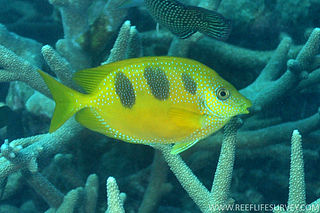
Siganus trispilos, the threeblotched rabbitfish, threespot rabbitfish, threeblotch spinefoot or threespot spinefoot is a species of marine ray-finned fish, a rabbitfish belonging to the family Siganidae. It is endemic to the eastern Indian Ocean off northwestern Western Australia.
